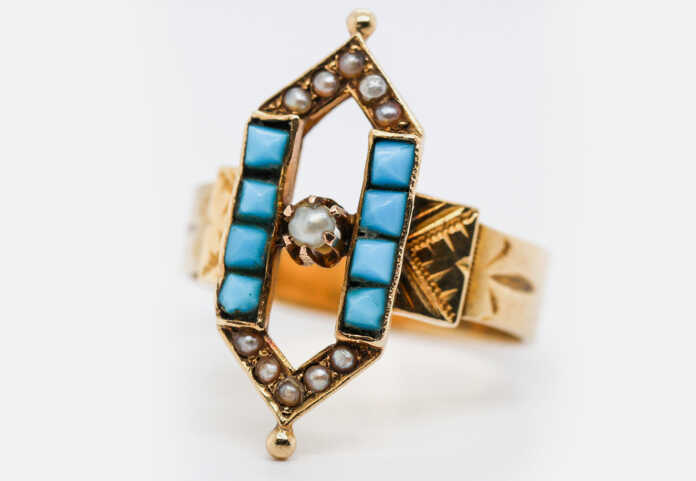
Turquoise, a gemstone with a history spanning millennia, has been valued for its unique beauty and cultural significance worldwide. Known for its distinct veiny patterns, or “matrix,” and its varying shades of blue and green, turquoise remains an enduring symbol of status, protection, and spirituality.
The Colours and Origins of Turquoise
Turquoise is a hydrated phosphate of copper and aluminium, known for its striking hues, which range from greenish-grey to vivid sky blue. Sky blue is considered the most desirable shade, prized for its clarity and vibrancy. Historically significant sources of turquoise include Iran, the Sinai Peninsula, and the southwestern United States, particularly Arizona, California, Colorado, and New Mexico.
Beyond these regions, turquoise deposits are also found in Afghanistan, Australia, Chile, China, Mexico, Peru, Tibet, and Turkestan. Each locality produces turquoise with unique characteristics, contributing to its global appeal.
Turquoise in Ancient Egypt
In Ancient Egypt, turquoise was mined and revered as far back as 7,500 years ago. The gemstone was closely associated with Hathor, the goddess of love, motherhood, and music. Turquoise was incorporated into ceremonial items and jewellery, often reserved for royalty and the elite.
Prominent examples of its use include the adornments in Pharaoh Tutankhamun’s tomb and a turquoise bracelet found on the mummified arm of Queen Zar, dating to Egypt’s first dynasty around 5,500 BCE. These artefacts highlight the gemstone’s significance in Egyptian culture and its role in representing power and divinity.
The Persian Contribution to Turquoise
Persian turquoise, known for its robin’s egg blue hue, has been mined in northeastern Iran since 4,000 BCE. It was considered a symbol of the heavens, often used to decorate sacred architecture, such as palace domes and mosques. Persian artisans incorporated the stone into intricate mosaics, a practice that influenced jewellery and art globally.
The name “turquoise” is derived from the French word Turquie, meaning “Turkish stone,” as it was transported to Europe via Turkish trade routes. While Persian turquoise is celebrated for its purity and lack of veining, today, the term also serves as a quality descriptor for matrix-free turquoise from other regions.
Turquoise in South American Civilizations
In South America, ancient cultures such as the Aztecs, Toltecs, and Olmecs prized turquoise for its aesthetic and ceremonial value. The gemstone was used in masks and ornaments for the nobility, reflecting its importance in social and spiritual hierarchies.
The Mayan civilization held turquoise in even higher regard, reserving it exclusively for religious artefacts and representations of deities. This exclusivity underscores its elevated status in Mayan society.
Turquoise in Indigenous North American Culture
In North America, turquoise has been central to Indigenous cultures for thousands of years. High-quality turquoise from mines in New Mexico and Arizona was extensively traded among tribes. The gemstone was often used in carvings, mosaics, and ceremonial items.
The Apache attributed protective and functional properties to turquoise, believing it enhanced the accuracy of weapons. By the late 19th century, Indigenous artisans began creating turquoise and silver jewellery, incorporating techniques introduced by European settlers. This distinctive style became synonymous with Southwestern art and remains widely appreciated today.
The Mystical Qualities of Turquoise
Throughout history, turquoise has been associated with protective and healing properties. It was believed to safeguard its wearer, ease ailments, and even detect danger by changing colour. In Medieval Europe, it was thought to absorb negativity, provided it was given as a gift rather than purchased.
These beliefs have contributed to the gemstone’s enduring appeal, reinforcing its reputation as a symbol of protection and spiritual significance across diverse cultures.
















